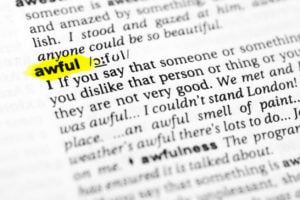Writers like to collect words. We delight in finding them and pocketing them away for the next time we’re grasping for that perfect expression. Since studying descriptive grammar in college as a linguistics major (and being wholly ruined for prescriptivist grammar), I have also learned to collect phrases that are common in natural speech but forbidden by grammarians.
We talk a lot about prescriptive grammar rules on our blog, so today, I want to share my joy in the use of double or multiple modals, as in the phrase “She might could swim”.
Hold Up. What’s the Difference Between Descriptive & Prescriptive Grammar?
Standard English Grammar has some very impressive ideas about how we should talk and write. This is what is known as prescriptive grammar because it “prescribes” an artificially “correct” way to use language. Almost none of us actually follow these rules all the time, though. An easy example of this is dangling prepositions.
The rule that no sentence should end in a preposition was basically created from thin air in 1672, according to The Cambridge Grammar of the English Language. People break this rule all the time. For example, we ask questions like, “What are you thinking about?”. In natural speech, very few of us would ever ask, “About what are you thinking?”.
This is a classic example, mainly because this rule against preposition stranding actually exists in a total of zero real human languages. Dangling prepositions is just something that people do. This is the kind of thing that concerns the Grammar of Linguistics, or descriptive grammar. Linguists are interested in how people actually speak, not how they “should” speak.
Why is this relevant? Well, people use double modals in natural speech all the time, even though prescriptive grammar tells us they might should not.
What are Double Modals, Exactly?
In English, the modal verbs make up a subset of auxiliary verbs. That set includes can (could), may (might), shall (should), will (would) and must, and sometimes ought, dare, need, and a few others. These ‘modal auxiliaries’ modify the modality of a sentence by expressing possibility or necessity.
For example, when you say, “I jump,” you express that you spring from the ground into the air. When you say, “I might jump,” you express that there is a possibility of your doing so.
Modals have a number of properties that differentiate them from other types of verbs. Those can get a bit technical, so you can read about them here if you’re interested. Two examples are as follows:
1. Modal verbs have no special 3rd person singular form (e.g. You can say, “she swims,” but not “she cans swim.”)
2. Modal verbs have no non-finite forms (e.g. When asked, “What is she doing?” You can answer with, “swimming,” but not “canning swim.”).
A double modal is a linguistic construction in which two modal auxiliaries are used in succession to introduce two separate modalities into a sentence. For example, to express that there is a possibility that you have the ability to jump over the bush, you might say something like, “I might can jump over that bush”. In Standard English, you would express this as follows: “I might be able to jump over the bush”.
Here are some of my favorite examples, found while doing research for this post*:
- “Could you might give me a minute?”
- “I’ve always thought if you stayed on that road right there, you might would run smack into it.”
- “Maybe we might should plan to eat out.”
- “Those ducks must not can feel cold.” Found here.
Some English speakers even use triple modal constructions, which is why many people refer to these as “multiple modal” constructions. Here’s a great one from Sentence First:
It’s a long way and he might will can’t come, but I’m gonna ask.
*Unless otherwise mentioned, these examples were found in MultiMo, a database of multiple modal constructions.
Who Uses Double Modals?
Unlike with dangling prepositions, grammarians did not just make up the rule that prohibits this construction in Standard English. Rather, in the many dialects of English (there are hundreds), some dialects naturally allow them, and some don’t. The prescriptive grammar of Standard American English is based on a group of socially privileged dialects in the U.S., which happen (by simple chance, really) to be dialects that do not allow double modals.
The Yale Grammatical Diversity Project states that double modals are found in “…areas that span from Florida to West Texas, and (going north) to southern Pennsylvania and New Jersey”.
They’re also found in patches of Utah and Michigan, and in large parts of Scotland and England. Oh, and New York City. This construction is also a common feature of African American English (that’s a technical term for a dialect of English spoken in NYC, mainly, but not exclusively by African Americans).
There are also double modals in many other languages, including Dutch and German. A Language Log post gives this amazing example from Dutch: “dat zou niet moeten kunnen“. Word for word, it translates as “that should not must can-be”. More broadly, it translates as “that ought not to be possible”. Basically, this construction is a feature of human language, whether grammarians like it or not.
Why do I Need to Know about This?
Well, there are two pretty good reasons, as far as I’m concerned. Here they are:
1. To understand language discrimination
There is a lot of stigma associated with using these constructions, as pointed out by Megan Risdal in her blog. When asked about them, people often say that using them makes speakers sound ”uneducated” or “stupid”. When people make this kind of association, however, are they really associating those traits with the words themselves? That seems incredibly unlikely, given their cross-linguistic prevalence. It seems way more likely that people are actually associating these words with the people who typically use them: Southerners or African Americans.
When you look at it that way, the situation is a little bit nastier. It means that really, these observers are associating the undesirable characteristics with those certain groups of people and using the language as an excuse. This is how language discrimination happens. Knowing that these constructions are a part of natural human language might help you fight that discriminatory ideology.
2. Character writing
As a writer, constructions like these are an amazing resource! You can use them to create realistic Southern or Appalachian characters and dialogue (these are the groups with whom this construction is most often associated), educate a reader on their regional prevalence, or dive into explorations of language with pronounced character juxtapositions.
As native speakers of these dialects will tell you, you can also use these constructions to add shades of meaning that only speakers will understand. There’s a great example of this in a post from Mr. Verb, in which a speaker explains that using a double modal construction in place of an adverb (e.g. “might could,” rather than “maybe”) will give a knowing listener the sense that the speaker is biased toward a certain answer.
Fun fact: There is also some suggestion that double and triple modals are used to reinforce that good ol’ fashioned southern politeness. Some Southerners will explain that telling someone they “should” do something is much bossier than telling someone they “might should” do something. The least intrusive way to say this would be to suggest that they “might oughta should” do it.
As a writer, having a larger phrase inventory will never hurt you. After all, you never know when you might could use a double modal in your next novel.
Do you have thoughts or feelings about double modals? Are you a native speaker or do you have a great example of your own? Let’s nerd out, reach out to us on social!



